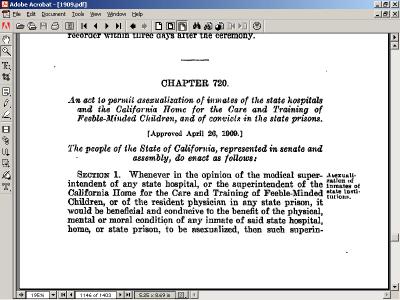I return herewith, without my approval Senate Bill No. 35, entitled "An Act for the prevention of idiocy."
This bill has what may be called with propriety an attractive title. If idiocy could be prevented by an act of assembly, we may be quite sure that such an act would have long been passed and approved in this state, and that such laws would have been enacted in all civilized countries. The subject of the act is not the prevention of idiocy, but it is to provide that in every institution in the state, entrusted with the care of idiots and imbecile children, a neurologist, a surgeon, and physician shall be authorized to perform an operation upon the inmates "for the prevention of procreation.." What is the nature of the operation is not described but it is such an operation as they shall decide to be "safest and most effective." It is plain that the safest and most effective preventing procreation would be to cut the heads off the inmates, and such authority is given by the bill to this staff of scientific experts. It is not probable that they would resort to this means for the prevention of procreation, but it is probable that they would endeavor to destroy some part of the human organism. Scientists, like all other men whose experiences have been limited to one pursuit, and whose minds have been developed in a particular direction, sometimes need to be restrained. Men of high scientific attainments are prone, in their love for technique, to lose sight of broad principles outside of their domain of thought.
A surgeon may possible be so eager to advance in skill as to be forgetful of the danger to his patient. Anatomists may be willing to gather information by the infliction of pain and suffering upon helpless creatures, although a higher standard of conduct would teach them that it is far better for humanity to bear its own ills than to escape them by knowledge only secured through cruelty to other creatures. This bill, whatever good might possibly result from it if its provisions should become a law, violates the principles of ethics. These feeble-minded and imbecile children have been entrusted to the institutions by their parents or guardians for the purpose of training and instruction. It is proposed to experiment upon them, not for their instruction, but in order to help society in the future. It is to be done without their consent, which they cannot give, and without the consent of their parents or guardians, who are responsible for their welfare. It would be in contravention of the laws which have been enacted for the establishment of these institutions. These laws have in contemplation the training and the instruction of the children. This bill assumes that they cannot be so instructed and trained. Moreover, the course it is proposed to pursue would have a tendency to prevent such training and instruction. Everyone knows, whether he be a scientist or an ordinary observer, that to destroy virility is to lessen the capacity, the energy and the spirit which lead to effort. The bill is, furthermore, illogical in its thought. Idiocy will not be prevented by the prevention of procreation among these inmates. This mental condition is due to causes many of which are entirely beyond our knowledge. It existed long before there were ever such inmates of such institutions. If this plan is to be adopted, to make it effective it should be carried into operation in the world at large, and not in institutions where the inmates are watched by nurses, kept separate, and have all the care which is likely to rendered procreation there very rare, if not altogether impossible. In one of these institutions, I am reliably informed, there have only been three births in ten years. A great objection is that the bill would encourage experimentation upon living animals, and would be the beginning of experimentation upon living human beings, leading logically to results which can be readily forecasted. The chief physician, in charge at Elwyn, has candidly told us, in an article recently published upon "Heredity," that "Studies in heredity tend to emphasize the wisdom of those ancient peoples who taught that the healthful development of the individual and the elimination of the weakling was the truest patriotism -- springing from an abiding sense of the fulfillment of a duty to the state."
To permit such an operation would be to inflict cruelty upon a helpless class in the community which the state has undertaken to protect. However skillfully performed, it would at times lead to peritonitis, blood poisoning, lockjaw and death.
For these reasons the bill is not approved.
SAML. W. PENNYPACKER
Governor of Pennsylvania
1905




